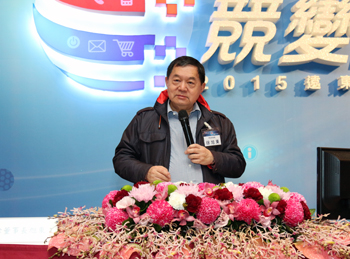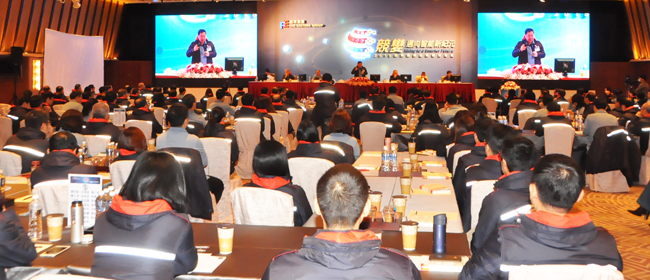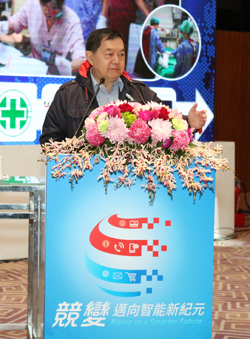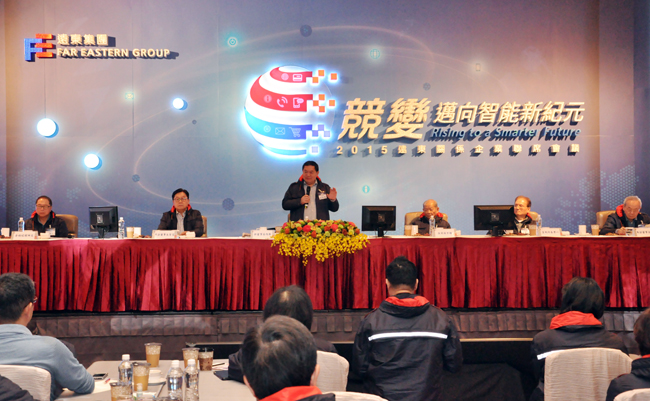2016年01月號 领航者的话
Rising to a Smarter Future
Far Eastern Group Chairman / Douglas Hsu


In order to help you seize opportunities in this dynamic era and embrace the smart future, the characteristics of digital era, applicable mindsets, and the forthcoming changes in industry and competition are listed below:
1.Digital Era
The digital era is equipped with the following three characteristics:
(a)From isolated to hyper-connectedness:From a picture taken in 2005 at St. Peter’s Square in Vatican, you can see there was only one camera phone among the crowd. That was the beginning of 3G era, data transmission was not fast enough so the crowd was individually isolated. At the same location in 2013, almost everyone owned a mobile phone, “sharing and connectedness” had already embedded into people’s lives. In the near future, the level of connectedness will be further deepened and enlarged. The current smartphones and tablets may eventually be replaced by wearable devices such as smart watches and glasses. The industry should plan in advance regarding upcoming changes in this dynamic environment.
(b)Millennials have become the major force:For Generation X, the three major survival elements are air, water and food. Yet for the Generation Y (or the Net Generation), they are Android, WhatsApp and Facebook. The Generation Y, born between 1981 to 2000, has been exposed with the rising power of Internet period, so they are much tech-savvy in digital products. Not only are they the major consumers for the next decades, but also the main labor contribution in the following 20 years. If you can understand their mindsets, you can be in control of future market needs.
(c)Ubiquity competition:Competition may come from everywhere and anywhere, or even from totally unrelated industries. “Digitalization” plays a critical role. Through digital technology, Alibaba’s “Ant Financial” has now extended services into payment, deposit, personal finance, and loan, etc. The Far Eastern Group has also been promoting the integration and elevation of digitalization to maximize group synergies.

2. Flipping Mindset
Facing with rapid market dynamics, we must abandon the old concept and embrace the new mindset. Listed below are the five major mindsets in this digital era:
(a)Cost down and value creation:As the life cycle of products and services has become shorter and shorter, without continuous upgrading, they will turn into commoditization. Facing with such challenges, enterprises often focus on “cost down” to remain competitive. Therefore, during economic slowdown, we often hear about the news of streamlined manpower. However, the cost down approach is quite limited and the original advantage could be copied quickly by competitors. Thus, we should focus on customers’ needs to create differentiated services or products.
(b)Disengagement:Resources are limited, when there is no more growth potential, enterprises should apply disengagement strategies and release manpower, financial and other resources to more promising businesses. This year’s Group Annual Meeting, we present you the book titled “The End of Competitive Advantage” exploiting six different disengagement strategies in accordance with their respective degree of urgency and capability.
(c)Transformation of ownership and the right to use:With the changes in consumption pattern, consumers no longer wish to own certain products or services, but only need to gain the right to use at the particular time. The rise of such “access economy/shared economy” brings infinite possibility for future business model. For instance, the shared automobiles model, there are nearly 5 million registered users globally in 2014, and up to 100,000 vehicles joined services, making leasing an automobile as easy as borrowing a bicycle.
(d)Consumer may also be the producer:Under traditional economy, producers offer value to consumers in exchange of payments, the boundary between them is very defined. In contrast, consumers often play the role of producers in this digital era, such as publishing on blogs, Wechat/Twitter, Facebook, these are contents provided by consumers.
(e)Change:Lamigo Monkeys is the latest professional team to join the Chinese Professional Baseball League and the least funded. By creating irreplaceable experiences, the team is able to attract fans and audiences. During the past 5 years, its revenue growth and scale have ranked top among the four professional teams, which exemplifies a success story of transformation. While many companies within our Group are in traditional businesses, with continuous transformation and upgrade, cross-industry collaboration may expand our core competence in different industries, groups, or devices. Thus, the Group’s innovation strategy team has been assisting affiliates, such as Far Eastern Retail Group, U-Ming Marine Transport, Far Eastern New Century, and Far EasTone Telecommunications to undergo transformation in products and services with significant impact.

3.Reshaping Industry Competition
Smart connectedness is the vital founding stone of digital era. According to research institutes, they have forecasted that more than 20 billion devices will be connected globally in three years and will produce enormous amount of data. Through analyzing and implementing these data, it will reshape the industry landscape and competition tremendously, which includes the following:
(a)New building blocks:Business operations comprise of users, things, platforms, digitalization, data, and capabilities. Although the building blocks may be the same in contrast to the past, their access and implementation have changed drastically in the digital era. For instance, users’ active participation is contributing greatly to the elevation of products and services. The importance of platforms is to expand products or services and improve capability to connect with other ecosystems. The connection with Internet and merchandise may improve the intelligent function or service performance of things (products). As the data have been generated massively, the enterprise should understand how to implement the Big Data to create value. Furthermore, the required investments (such as capital, plant, equipment, technique, etc.) are easily accessible and adjustable. In other words, the high threshold to establish large enterprise has been lowered considerably.
(b)New industry boundaries:Entering into the digital era, the basis and boundary of competition has differed significantly from the past, moving from single product competition to multi-system competition. For example, a company that produces rice cooker used to compete with other brands, yet in future it will have to compete with a larger rice supply system, or even the health management system.
(c)New disruptive technologies:McKinsey Global Institute pointed out that 12 potentially disruptive technologies would transform life, business models and the global economy. Among the 12 technologies, more than half are connected with digital technology including mobile internet, knowledge automation, the Internet of Things, cloud computing, advanced robotics, self-driving vehicles, next-generation genomics, energy storage, etc. These technologies which only appeared at science fiction movies is now turning into reality one by one along with developments of the digital technology.
(d)New demand:At last year’s annual Group Meeting, I mentioned that under Industry 4.0, small quantity, diversity, quick response, and just-in-time production shall mark the future of the manufacturers. Customer needs will pull the overall industry chain to form a “sales based” production. Therefore, in the digital era we should focus outward to connect with the supply chain and demands of the whole system.
(e)New business model:GE, the world’s leading manufacturer used to be an industrial company that simply sold products about 30 years ago. Since 2010, GE launched “Outcome based service” business model to help improve customers’ managing performance through Big Data and IoT, and assisted customers to use GE products more efficiently. By shifting from “selling product” to “selling service”, GE has created more stickiness in customer relations.

4.Conclusion
The theme of this year’s Annual Group Meeting is “Rising to a Smarter Future”. According to the book we prepared for you titled “The End of Competitive Advantage”, the long lasting competitive advantage no longer prevails. More and more industries are facing with the vanishing competitive advantage. “Change” is not as risky as we think; in contrast, “stability” is the most risky state. In view of the transient competitive advantage, industry should focus on continuous reconfiguration, steadily review positive disengagement, use resource allocation to promote deftness, and build innovation proficiency.
In reference to the passages from “Alice Wonderland,” “Here we must run as fast as we can, just to stay in place. And if you wish to go anywhere, you must run twice as fast as that.” Speed really matters, if you do not grow and change quickly, you will be left behind by other competitors.
Aside from speed, we must set goals to achieve business targets. The Far Eastern Group aims to march steadily toward the next 60 years. You are all new leaders for the Group’s next generation. Hope that you understand our current environment; always reflect the position of our industry under this highly connected era? Are we unique? What is the strategic planning for the next 3~5 years? Is our goal SMART (Specific Measurable Attainable Realistic Time-limited)? Is the KPI (Key Performance Indicator” set reasonably? Do we continue the organization restructuring, transformation, and upgrade? Facing with ubiquitous competition, we should all be ready to rise to a smarter future.
******************************************



















